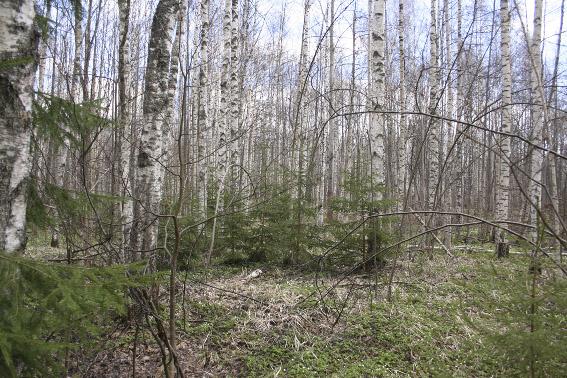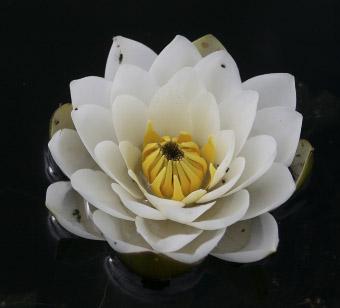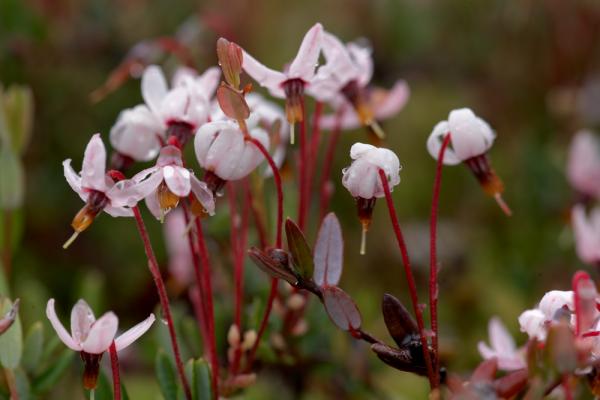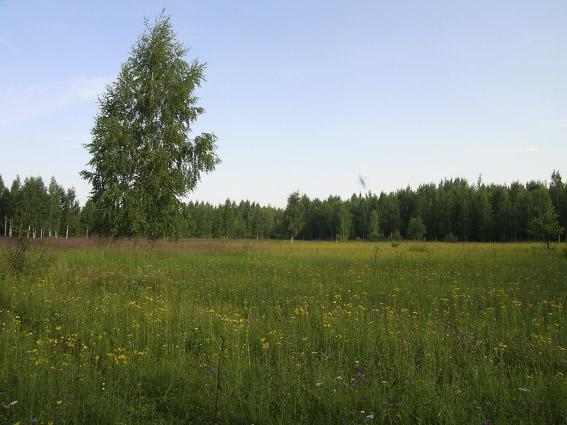The territory of the Polistovsky Reserve is located in the northern part of the belt of coniferous-broad-leaved forests, but the features of the geomorphological structure and the soil cover of the southern part of the Preilmenskaya lowland impose their significant imprint on the vegetation character. Leveled surface of soil-forming rocks, abundance of ribbon clays and poor drainability of the territory cause not only a high degree of bogging, but also a wide distribution of pure spruce forests and a small proportion of broad-leaved species. Typical coniferous-broadleaved forests of the Polistovsky Reserve, as a rule, are confined to elevated elements of relief, or to relatively well-drained areas along river valleys. The composition of the lower forest tiers is similarly heterogeneous.
The forests of the mineral coast of the Polistovsky Reserve, as well as those of the nearby mineral islands within the bog, have been repeatedly cut down during the last many centuries, and most of the cleared areas have been plowed or used as hayfields (since natural floodplain meadows on the adjacent territory have an extremely limited distribution). However, by the beginning of the 20th century, the mineral coast of the Polistovsky bog was a vast belt of forest. From the early 20's up to the early 40's the most part of the area was felled (in particular almost all forests on mineral islands in the southern and western parts of the bog were cut down). Intensive logging continued up to the present time, although the reserves of mature timber in this area were already very low.
The Polistovo-Lovatskaya bog massif belongs to the Ladoga-Ilmensko-Westdvinsky province of oligotrophic ridge-peatlands of the convex oligotrophic peatland zone (Katz 1948). The massif occupies a significant part of the watershed of the Polistia and Lovati rivers and is a typical for this province watershed-slope peatland by its morphology.
The poverty of soils in the Polistovsky Reserve with elements of mineral nutrition is associated with a low inflow of saturated water in the central parts of the peatlands, the absence of upward currents and slow decomposition of residues. Besides, products of incomplete decomposition of organic residues: humic acids, methane, hydrogen sulfide are formed in peat. High acidity and the constant growth of peat, which for the forest zone of the European part of Russia is about 1 m per thousand years, have an adverse effect on plants (Boch, Mazing 1979). Due to the later thawing of soils and the high level of spring water standing, the vegetation of the Polistovsky bog massif has a shorter vegetation period than in the neighboring drylands. The timing of the main phenophases in the Polistovsky bog plants is shifted to later periods than in the same species growing in non-bog areas. All this provides the distinctive vegetation of the Polistovsky massif with the dominance of sphagnum mosses, evergreen shrubs and dwarf forms of pine, which gives this intrazonal landscape an appearance similar to forest tundra.
In the woods
At present, most of the forests on the mineral coast of the Polistovsky Reserve are represented by relatively young single-age forests. Despite this, the area is of considerable value, as young and middle-aged forests are of natural origin and develop practically without anthropogenic impact (some areas, remote from settlements and roads and surrounded by strips of windfall, have not been visited by people at all for many years). The composition of the forests of the Polistovsky Reserve reflects the initial distribution of tree species: in the eastern part the broad-leaved tree species (oak, linden, maple, less often ash and elm) are widely represented in the forests; in the southern and western parts the spruce-small-leaved and spruce forests are most widely represented, and the areas with a significant proportion of broad-leaved species occupy a small area. The northern part of the Polistovsky Reserve's bog coast is closer to taiga forests in character: broad-leaved species constitute a very small proportion of the composition of the tree layer; the grass cover is almost everywhere dominated by taiga small-grass species. Older forests occupy a small area of the Polistovsky Reserve. Mainly these are small fragments of spruce forests in the southern and southwestern parts of the swamp coast, the age of the main spruce generation in which reaches 200 years or more. Some of these sites are located at a considerable distance from roads and settlements and develop almost entirely without human impact.
There are two main groups of mineral islands on the territory of the Polistovsky bog: high, up to 9 m above the bog level, small hills and relatively low, with gentle slopes, but often having a large area of islands. These groups, however, are rather conventional, and it is impossible to draw a clear boundary between them. On the islands of the first group the stand is formed under the influence of occasional hurricanes and strong winds; the height of the stand is usually not more than 15 meters, the trees rarely reach a great age. Due to the small area of the islands, the composition of the stand is highly susceptible to various accidents. On the vast majority of islands of this type in the Polistovsky Reserve the stand is represented by birch downy, sometimes with a mixture of aspen, pine and spruce. However, there are also islands among this group (mostly located near the mineral shore or from large islands), in the stand of which broad-leaved tree species such as oak, maple and linden are found.
The richest in flora of those studied in the Polistovsky Reserve (Reshetnikova, Korolkova, Novikova 2006) are the islands of Dubovets, Gorodok, Beryozovik, Medvezhye, and Osinovik (eastern). The ground cover of these islands is also largely random and generally quite poor in species. As a rule, the grass and shrub cover is dominated by ground reed and reedgrass. Many of these islands, especially those located in the southern part of the marsh, show clear traces of relatively recent (pre-war) logging, but it is often difficult to determine how much of a role human activity has played in shaping the forest structure of a particular island. Among the islands of the Polistovsky Reserve of the second group there are many that were previously inhabited; although there are no inhabited islands at present, many of them are still connected by winter roads to the villages on the mineral bank, and until very recently the treeless areas on them were regularly mowed. Very many of the islands were cut down in the years before the war, as were the areas of the mineral shore close to them.
In the water
Swamp lakes of the Polistovsky Reserve are relatively monotonous in flora and vegetation - only thickets of mulberry (lat. Nuphar lutea) and reed (lat. Phragmites australis) are found here. No other hydrophytes were recorded. In the lakes of lake-denudation complex, lily of the valley (lat. Nymphaea candida) and mussel occasionally occur. The flora and vegetation of the rivers of the Polistovsky Reserve is richer. The most interesting in terms of flora is Lake Polisto. Unfortunately, only its northern part is included in the territory of the reserve, but it is in it extensive thickets grow pondweed (Potamogeton perfoliatus), lake reed (Scirpus lacustris), fescue reed (Scolochloa festucacea), there is a sundew (Butomus umbellatus). Already for a short period of observations of the lake's flora, a dynamic change of species near the mouth of the Osianka was noted: in 1998, V.G. Sergienko collected alpine pondweed (Potamogeton alpinus) and shining pondweed (P. lucens). Later in 2003, 2004, and 2006, despite special searches, were not found, but in 2003, the cereal pondweed (lat. P. gramineus L. s. l.) was observed in large numbers, and in 2006, its abundance decreased somewhat. The lake shore in the north is composed of sand with peat, and level fluctuations cause a constant change of vegetation groups on the shore, which deserves further research.
On the bog
The bogs of the Polistovsky Reserve are its main wealth. By the abundance of types and diversity of raised bogs, as well as by their area, the Reserve has no equals not only in the North-West of Russia, but also in the whole of Europe.
И. D. Bogdanovskaya-Gienef (1969) identifies the following five main complexes of biogeocenoses of the Polistovo-Lovat massif.
1. Pine-broadleaf-sphagnum biogeocenoses. In the Polistovsky Reserve are not uncommon, but have a small distribution. They are associated with small, well-drained areas of low-power deposit, up to 2-3 m deep. As a rule, they are formed when the pine forest dies out as a result of increasing moistening. Pine is represented by Litwinowii and Willkommii forms. In the herb-shrub layer there is abundant Eriophorum vaginatum, shrubs - cassandra (Chamaedaphe calyculata) and podbel (Andromeda polifolia). The continuous sphagnum cover is formed by Sphagnum magellanicum, Sph. angustifolium and less frequently Sph. fuscum.
2. Sphagnum transitional swamps. One of the most common biocenotic complexes on the territory of the Polistovsky Reserve. They occur either in narrow strips along the mineral coast of the bog and islands, or in large areas, occupying large spaces. They are formed in conditions of poor drainage with a plentiful inflow of water from the surrounding bogs and stagnant precipitation. The Polistovsky Reserve's swamps have an amazingly flat surface. Only rarely do Sphagnum magellanicum and Sph. angustifolium, rounded mounds with cassandra or underbelly on the background of Polytrychum strictum. Another characteristic feature of transitional swamps is almost complete treelessness. Only occasionally there are single small birches (lat. Betula pendula). The background is usually made from the most common plant association - Carex limosa + Menianthes trifoliata - Sph. obtusum. The association Scheuchzeria - Sph. majus + Sph. Jensenii is often occur. Quite frequent are soaks in which sphagnum dies off and is again occupied by Sph. jensenii. Among the Polistovsky Reserve's wetlands there are often winding strips with reed (Phragmites australis) or sedge (Carex limosa), almost devoid of sphagnum cover. Scheuchzeria is of great importance in the life of the swamps. With its strong rhizomes, it forms such a strong network that a human can easily walk on a living carpet of Scheuchzeria above buried rivers which are quite common in this biogeocenosis. The dead remains of Scheuchzeria emit gases, among which methane predominates, and they also have the ability to cause the surface layer of the peatland to float up. Floating of the vegetation cover and its lower parts is a distinctive feature of the sphagnum transient swamps of the Polistovsky Reserve, resulting in a layer of water up to 40 cm at a depth of 25-40 cm, i.e. in these swamps the formation of peat moss or floating mat.
3. Hollow-ridge complex (HRC). It occupies the largest area of all the complexes of the upper part of the Polistovsky Reserve. Such a significant distribution is explained by the peculiarities of the relief of the massif surface, namely the large area of slopes, on which it develops (on slopes from 0.001-0.002 to 0.008). The main feature of this biocenosis is the parallel arrangement of ridges and hollows, stretched in a direction perpendicular to the slope. I. D. Bogdanovskaya-Gienef (1969) distinguished two types of HRC: 1) with the association Sphagneta magellanici on ridges, which has a limited distribution, and 2) with Sphagneta fusci on ridges, which occupies an incomparably large area. Within these types, she identified several other variants of HRC, which differ in the location on the slope, the length and width of ridges and hollows, the ratio of their areas, the degree of abundance and the nature of pine growth, vegetation cover. HRC of the Polistovsky Reserve has a different character along the slope, the size of the hollows increases from the upper part of the slope to the lower part. The ridges are about 0.5 m high and extend across the slope, their width varies from 1 to 4-8 m. The length of ridges can reach several tens of meters. On the ridges there are cottonwoods and pines of various forms, sometimes they are absent or replaced by dwarf birch (lat. Betula nana). There are also significant quantities of cloudberry (lat. Rubus chamaemorus), heather (lat. Calluna vulgaris), Chamaedaphne, Andromeda. Ridges occupy 40 to 60% of the total area of the complex. Hollows differ in size, degree of watering, character of microrelief, and vegetation. The width of hollows is from 1 to 20 m, they can be several to several tens of meters long. The microrelief is mostly flat, but in the central part there are hillocks - remnants of buried dead hummocks. In the vegetation cover of hollows in the Polistovsky Reserve there are cotton-grasses, Scheuchzeria, Oreos (lat. Rhynchospora alba), Andromeda, sedges, sundews, mosses (Sph. balticum, Sph. cuspidatum, Sph. majus). In the central part of the hollows, the remains of degraded ridges are not uncommon; they are patches of bare peat, sometimes covered with liverworts or blue-green algae. Light yellow spots formed by sphagnum stalks lying on the surface, almost devoid of leaves and slightly slimy, are also common.
4. Top pine-sphagnum complexes. Developed on the tops of the Polistovsky Reserve bog, as well as on slopes with a significant gradient. These slopes are characterized by strong drainability, as a result of which HRC do not develop. Such slopes on the territory of the Polistovo-Lovatskaya bog massif are rare. However, well-drained strips along some bog rivers, e.g. the Hlawica river, are close to them in ecological conditions and the character of vegetation. Under these conditions, a continuous cover of Sph. magellanicum, sometimes with an admixture of Sph. Fuscum is developing. In level depressions Sph. Angustifolium is growing. Also very characteristic is the abundant development of cottongrass, whose cover reaches 40% here. Cloudberry, Chamaedaphne, Ledum, and Andromeda occur in large numbers. Pine is represented by all three of its bog forms, but mainly by the Litwinowii form. The pumila form is atypical and is found only as young specimens with their lower branches buried in moss. Top pine-sphagnum complexes for convex and narrow peaks are most characteristic. The predominant associations in them are Pinus sylvestris - Calluna vulgaris - Sph. fuscum, Pinus sylvestris - Chamaedaphne calyculata - Sph. magellanicum - Sph. fuscum. The carpet is characterized by the presence of blueberries and cranberries, the degree of coverage of which is 40-70%. Cloudberry is often absent, but its coverage reaches 70% in some places. Lichen spots are always present, and sometimes even cover up to 25% of the surface. There are no real hollows, usually there are their rudiments in the form of small depressions, 1-3 m in length with the association Eriophorum vaginatum - Sph. angustifolium + Sph. balticum.
5. The lake-denudation complex in the Polistovsky Reserve is located on relatively flat areas, with impaired flow. It is characterized by water veins with slowly flowing water and significant gas content in the upper strata of the deposit. Lakes may be located in strips or (less frequently) be scattered. The microrelief is ridge-like. Ridge height is 0.2-0.35 m, width about 2 m, often the ridges are broken up into separate hillocks. Ridges occupy a much smaller proportion of the entire surface than in the HRC (less than 25-30%). The ridges are dominated by Sph. rubellum and Sph. Fuscum. While heather, cotton-grass, and Chamaedaphne occur in significant numbers; lichen patches are common. The rare pine of the Willkommii form, usually less than 1 m in height, and the pumila form, whose broad clumps are 20-40 cm above the moss, can be found on the ridges. Apart from them, single thin birches of Betula pendula grow up to 2.5 m high.
This complex of the Polistovsky Reserve has a peculiar appearance due to hollows. They are of 4 types.
1. Sphagnum type has the usual vegetation cover, formed by cenoses of Scheuchzeria and mud sedge with Sph. cuspidatum, distinguished by lush growth.
2. the Jungermannian, or black hollows, occupy a particularly large area in lake strips. They owe their black color to liverworts (Gymnocolea inflata and Cephalozia fluitans). Some of these hollows are completely devoid of sphagnum, while others have sphagnum hollows lying in individual, desiccated shoots or in small groups.
3. Denuded peat spots are similar in appearance to Jungermannian hollows, but represent bare peat, which, when oxidized, takes on a black color. On hot summer days, the surface of denuded spots, like black hollows, is covered with large blisters (10-13 cm in diameter and 2.5 cm in height), gas comes out when they burst.
4. The hollows with vegetation atypical for raised bogs occupy a small area, but are of great indicative value. Most often there are thickets of unusually high (up to 40 cm) and dense Scheuchzeria with an area of 1-2 m2. Also noted are Menyanthes and narrow-leaved cotton-grass (lat. Eriophorum angustifolium).
On the meadow
Meadows on the territory of the Polistovsky Reserve and in its protection zone are floodplain hayfields and meadows on the site of former villages - former hayfields around and fallows on the site of settlements. Now it is a lot of tracts of different size, in the center of some of them there are remnants of village plantations, or even Platanthera chlorantha. The most extensive tracts are Ratcha, Nesvino, Plavnitsa, Bolshoye Gorodishche. On the territory of the Polistovsky Reserve are meadows of the tract Zakhod, as well as small meadows on the edge of the bog, where, apparently, small farms used to be located; other meadows are located in the protection zone.
Many meadows in the Hlavica river valley were reclaimed in the second half of the twentieth century and sown with grass mixtures, which considerably impoverished their floristic composition. Some meadows were plowed and planted with spruce, for example, on Medvezhye Island. One of the richest in flora meadows of the Polistovsky Reserve is located 0.5 km south of the Obolonye tract. There are a lot of rocks, so it was mowed irregularly and not ameliorated. Orchids are very numerous in the meadows of Lugi tract (east of the village of Usadba) and in the meadows of Sapozhok tract.







